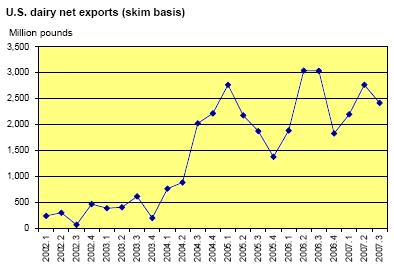



USDA Livestock Outlook - Beef and Dairy
By U.S.D.A., Economic Research Service - This article is an extract from the December 2007: Livestock, Dairy and Poultry Outlook Report, highlighting Global Poultry Industry data.
Cattle/Beef
Heavy Cow And Calf Slaughter Could Affect January 1 InventoriesTotal commercial cow slaughter continues heavy—beef cow slaughter in the Southern States and all cow slaughter in the Eastern Corn Belt and Central Appalachian States is heavier than last year, based on weekly data through Thanksgiving week 2007. Recent precipitation in the Southeastern and Southwestern States could blunt this apparent liquidation mindset to the extent that cool season pastures can get enough of a boost to make a difference in forage and supplemental feed needs for the cow herd through the winter. Dairy cow slaughter has been high much of this fall, despite milk prices about half-again higher than 2006 prices. However, high hay, corn, and protein costs have taken the luster off the high milk prices, and some cows may be going to slaughter to make way for dairy replacement heifer inventories, which are thought to be at herd-building levels. The dairy replacement heifer inventory was one of the few categories that increased over 2006 inventories in the July Cattle inventory report.
In 2006, beef cows were going to slaughter at a rate of about 18 percent over 2005 beef cow slaughter, and dairy slaughter was at about 4 percent above 2005 slaughter. In 2007, the rate of beef and dairy cow slaughter were closer to even, with cumulative annual beef cow slaughter through October 2007 about 7 percent above cumulative beef cow slaughter through October 2006, and dairy cow slaughter just under 8 percent. For 2007, total cumulative commercial cow slaughter through October 2007 is 7 percent ahead of cumulative slaughter through October 2006 and is 19 percent ahead of slaughter for the same period in 2005.
Some analysts suggest the cattle cycle has gone the way of the hog and dairy cow cycles. Based on total beef and dairy cow inventories, some analysts have suggested that the cattle cycle has returned to its liquidation phase. Cow inventories have increased a maximum of less than half of 1 percent since the low 41.851- million-cow inventory on January 1, 2004, and cattle and calf inventories have increased by just over 2 percent from January 1, 2004 to January 1, 2007.
This 2-percent increase in total cattle and calf inventories is about half of the (4- percent) increase observed from the low cattle and calf inventory on January 1, 1979 to the peak January 1, 1982 inventory for the cattle cycle of the 1980s. That peak was followed by 8 years of liquidation, reaching a low January 1, 1990. Total cumulative calf slaughter is also well ahead of slaughter for the same periods in 2005 and 2006. This level of calf slaughter is likely to make inroads into January 1, 2008’s total cattle and calf inventory, which is scheduled to be released February 1, 2008 in the National Agricultural and Statistics Service’s Cattle report. Low cattle inventories could lead to reduced supplies of feeder cattle and the potential for reduced beef supplies in 2008 and 2009.
Feeder cattle prices are declining for a number of possible reasons, the foremost of which is lack of wheat pasture this winter. Wheat pasture is lacking because of the current high prices for wheat and concerns that, in its current suboptimal state, wheat might not stand up to grazing pressure this winter. Another reason for declining feeder cattle prices is the profit picture for cattle feeding—currently negative, as it has been beginning in June 2007.
However, a quick glance at live cattle futures over the last several months shows a number of instances where cattle feeders could have hedged fed cattle at $1 per pound or better into Spring 2008. To the extent that such hedging took place, at least some cattle feeders may be better off than a first glance would indicate.
Packers do not have the same venues for hedging commodity beef. Cutout values for Choice beef have increased since Thanksgiving, but this recovery is by fits and starts, leaving beef packers walking on the negative side of a thin line between maintaining market share in the face of pressure from newcomer JBS and, so far, unsuccessful attempts to either raise beef prices or reduce cattle prices.
The apparent strength in fed cattle prices into mid-December 2007 suggests that market-ready cattle are in relatively short supply. However, points that do not necessarily support that view include: (1) the continually heavy dressed weights and numbers of fed cattle slaughtered, (2) a relatively high share of Choice-grading fed cattle in the fed cattle mix, (3) the November 1, 2007 number of cattle that have been on feed for more than 120 days (indicative of heavy supplies of market-ready cattle on the front burner, so to speak) compared to previous Novembers, except for last year’s record (since 1996), and (4) the low price for the 50-percent lean trim from fed cattle that is mixed with leaner trim from culled cows and bulls and imported processing beef.
Retail Choice beef prices at this point in 2007, which are relatively high by some views, remain well above 2006 prices for the same months. Cumulative beef exports are higher through October this year than through October last year and expected to be well above 2006, while cumulative imported beef is slightly ahead of 2006 imports. Cumulative beef production is slightly ahead of last year’s cumulative production for the same period. As net a result, per capita domestic disappearance is expected to be down slightly from last year and, if nothing else changes, means consumers will face higher prices this year than last.
Dairy
Higher Feed Prices Dampen Milk Production Expansion in 2008;That and Firm Demand Will Keep Prices from Dropping Steeply
Sharply higher feed costs projected for 2008, especially for soybean meal, will cut into dairy producer profits. Offsetting higher feed costs are moderating prices for alfalfa hay and relatively high prices for milk. The milk-feed price ratio will be lower in 2008 compared with this year, and will likely slow the pace of expansion. The December Milk Production report showed November production still increasing at above the long-term average rate. Both cow numbers and production per cow are well above year-earlier levels and sharply above those in the first half of 2007. These fundamentals should boost milk production in 2008 by about 1.1 percent. Forecast 2008 production is 190.5 billion pounds.
October output of butter, total cheese, and nonfat dry milk (NDM) continues to outpace year-earlier levels by 9.1 percent, 1.6 percent and 41.4 percent respectively, according to the November Dairy Products report. Cheddar cheese prices remain at near-record levels of over $2 a pound. The Foreign Agricultural Service reports 10- month imports of quota cheese are lagging the same period in 2006 by 3 percent. However, the Dairy Market News reports that export interest may be building. For butter, the October drawdown in stocks set a record for that month, and commercial disappearance through September was 5.6 percent above year-earlier levels. World butter prices are above U.S. prices and could help boost export interest. Export potential for both cheese and butter, combined with firm domestic demand, will likely support prices for both products into the first half of 2008. Cheese prices could soften later in 2008.
The NASS cheese price is expected to average from $1.735 to $1.745 per pound in 2007 and from $1.640 to $1.720 per pound in 2008. The butter price will likely follow a similar pattern, averaging from $1.330 to $1.360 per pound in 2007 and slipping to $1.205 to $1.315 per pound in 2008. NDM prices soared in the second half of 2007, which will push the 2007 average price to the range of $1.705 to $1.725 per pound. In 2008, prices should decline somewhat to average from $1.645 to $1.705 per pound. Ample U.S. production and large stocks could pressure prices later in 2008. However, global supplies remain tight. Whey prices have fallen precipitously in the second half of 2007 and will likely average from 59.5 to 60.5 cents a pound this year, based mostly on earlier highs. Next year, prices will be closer to current prices and average from 43.0 to 46.0 cents a pound. Weaker export prospects in late 2007 and into 2008 will keep whey prices below early 2007 peaks.
While milk prices should be lower in 2008 than in 2007—a steep drop is not forecast. The Class IV average price is forecast to range from $17.40 to $18.30 per cwt in 2008, down from $18.30 to $18.50 per cwt in 2007. The Class III price is expected to average $16.15 to $16.95 per cwt in 2008, compared with $18.00 to $18.10 per cwt in 2007. The all milk price will average from $18.00 to $18.80 per cwt in 2008, down slightly from the $19.05 to $19.15 per cwt expected in 2007.

Further Reading
|
|
- You can view the full Outlook report by clicking here. |
December 2007


